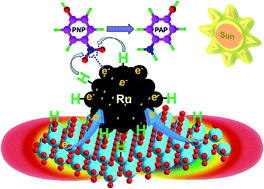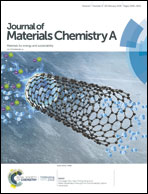Plasmonic Ru/hydrogen molybdenum bronzes with tunable oxygen vacancies for light-driven reduction of p-nitrophenol†
Abstract
To meet the requirement of high catalytic efficiency toward the reduction of toxic p-nitrophenol (PNP) to useful p-aminophenol (PAP), we herein report Ru supported on heavily hydrogen-doped semiconductors, specifically Ru/hydrogen molybdenum bronzes (Ru/HxMoO3−y), which is prepared via a facile H-spillover route. Detailed characterization by means of UV-vis-NIR diffuse reflectance, XRD, TEM, and XPS measurements reveals that Ru/HxMoO3−y (100) (100 means the hydrogen reduction temperature (°C)) exhibits strong visible light absorption with a plasmonic peak at around 690 nm, which can be tunable by varying its stoichiometry. Under visible light irradiation, the Ru/HxMoO3−y (100) hybrid displays superior catalytic activity to photocatalytic reduction of PNP relative to that under dark conditions, in which HxMoO3−y acts as electron-donor centres and Ru NPs act as active centres. More importantly, a proposed mechanism for the N–O bond reduction on the Ru/HxMoO3−y hybrid is presented. This study provides a new avenue to design efficient plasmonic metal/semiconductor hybrids for green chemistry.



 Please wait while we load your content...
Please wait while we load your content...